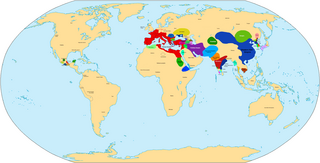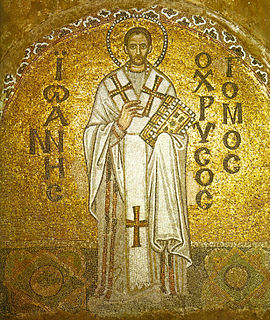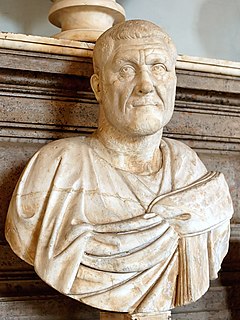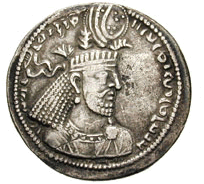
The terms anno Domini (AD) and before Christ (BC) are used to label or number years in the Julian and Gregorian calendars. The term anno Domini is Medieval Latin and means "in the year of the Lord", but is often presented using "our Lord" instead of "the Lord", taken from the full original phrase "anno Domini nostri Jesu Christi", which translates to "in the year of our Lord Jesus Christ".

AD 1 (I), 1 AD or 1 CE is the epoch year for the Anno Domini calendar era. It was the first year of the Common Era (CE), of the 1st millennium and of the 1st century. It was a common year starting on Saturday or Sunday, a common year starting on Saturday by the proleptic Julian calendar, and a common year starting on Monday by the proleptic Gregorian calendar. In its time, year 1 was known as the Year of the Consulship of Caesar and Paullus, named after Roman consuls Gaius Caesar and Lucius Aemilius Paullus, and less frequently, as year 754 AUC within the Roman Empire. The denomination "AD 1" for this year has been in consistent use since the mid-medieval period when the anno Domini (AD) calendar era became the prevalent method in Europe for naming years. It was the beginning of the Christian/Common era. The preceding year is 1 BC; there is no year 0 in this numbering scheme. The Anno Domini dating system was devised in AD 525 by Dionysius Exiguus.
AD 4 was a common year starting on Wednesday or a leap year starting on Tuesday of the Julian calendar and a leap year starting on Tuesday of the Proleptic Julian calendar. At the time, it was known as the Year of the Consulship of Catus and Saturninus. The denomination "AD 4" for this year has been used since the early medieval period, when the Anno Domini calendar era became the prevalent method in Europe for naming years.
AD 64 (LXIV) was a leap year starting on Sunday of the Julian calendar, the 64th Year of the Anno Domini designation, the 64th year of the 1st millennium, the 64th year of the 1st century, and the 4th year of the 7th decade. At the time, it was known as the Year of the Consulship of Bassus and Crassus. The denomination AD 64 for this year has been used since the early medieval period, when the Anno Domini calendar era became the prevalent method in Europe for naming years.
AD 95 (XCV) was a common year starting on Thursday of the Julian calendar, the 95th Year of the Anno Domini (AD) designation, the 95th year of the 1st millennium, the 95th year of the end of the 1st century, and the 5th year of the 10th decade. At the time, it was known as the Year of the Consulship of Augustus and Clemens. The denomination AD 95 for this year has been used since the early medieval period, when the Anno Domini calendar era became the prevalent method in Europe for naming years.
Year 104 (CIV) was a leap year starting on Monday of the Julian calendar, the 104th Year of the Anno Domini (AD) designation, the 104th year of the 1st millennium, the 4th year of the 2nd century, and the 5th year of the 100s decade. At the time, it was known as the Year of the Consulship of Suburanus and Marcellus. The denomination 104 for this year has been used since the early medieval period, when the Anno Domini calendar era became the prevalent method in Europe for naming years.
Year 118 (CXVIII) was a common year starting on Friday of the Julian calendar, the 118th Year of the Common Era (CE) and Anno Domini (AD) designations, the 118th year of the 1st millennium, the 18th year of the 2nd century, and the 9th and pre-final year of the 110s decade. At the time, it was known as the Year of the Consulship of Hadrianus and Fuscus. The denomination 118 for this year has been used since the early medieval period, when the Anno Domini calendar era became the prevalent method in Europe for naming years.
Year 136 (CXXXVI) was a leap year starting on Saturday of the Julian calendar, the 136th Year of the Common Era (CE) and Anno Domini (AD) designations, the 136th year of the 1st millennium, the 36th year of the 2nd century, and the 7th year of the 130s decade. At the time, it was known as the Year of the Consulship of Commodus and Civica. The denomination 136 for this year has been used since the early medieval period, when the Anno Domini calendar era became the prevalent method in Europe for naming years.

Year 398 (CCCXCVIII) was a common year starting on Friday of the Julian calendar, the 395th Year of the Common Era (CE) and Anno Domini (AD) designations, the 398th year of the 1st millennium, the last 3 years of the 4th century, and the 9th and pre-final year of the 390s decade. At the time, it was known as the Year of the Consulship of Augustus and Eutychianus. The denomination 398 for this year has been used since the early medieval period, when the Anno Domini calendar era became the prevalent method in Europe for naming years.
Year 175 (CLXXV) was a common year starting on Saturday of the Julian calendar, the 175th Year of the Common Era (CE) and Anno Domini (AD) designations, the 175th year of the 1st millennium, the 75th year of the 2nd century, and the 6th year of the 170s decade. At the time, it was known as the Year of the Consulship of Piso and Iulianus. The denomination 175 for this year has been used since the early medieval period, when the Anno Domini calendar era became the prevalent method in Europe for naming years.

Year 235 (CCXXXV) was a common year starting on Thursday of the Julian calendar, the 235th Year of the Common Era (CE) and Anno Domini (AD) designations, the 235th year of the 1st millennium, the 35th year of the 3rd century, and the 6th year of the 230s decade. At the time, it was known as the Year of the Consulship of Severus and Quintianus. The denomination 235 for this year has been used since the early medieval period, when the Anno Domini calendar era became the prevalent method in Europe for naming years.

Year 610 (DCX) was a common year starting on Thursday of the Julian calendar, the 610th year of the Common Era (CE) and Anno Domini (AD) designations, the 610th year of the 1st millennium, the 10th year of the 7th century, and the 1st year of the 610s decade. The denomination 610 for this year has been used since the early medieval period, when the Anno Domini calendar era became the prevalent method in Europe for naming years.
The proleptic Julian calendar is produced by extending the Julian calendar backwards to dates preceding AD 8 when the quadrennial leap year stabilized. The leap years that were actually observed between the implementation of the Julian calendar in 45 BC and AD 8 were erratic: see the Julian calendar article for details.

Year 295 (CCXCV) was a common year starting on Tuesday of the Julian calendar, the 295th Year of the Common Era (CE) and Anno Domini (AD) designations, the 295th year of the 1st millennium, the 95th year and last 6 years of the 3rd century, and the 6th year of the 290s decade. At the time, it was known as the Year of the Consulship of Tuscus and Anullinus. The denomination 295 for this year has been used since the early medieval period, when the Anno Domini calendar era became the prevalent method in Europe for naming years.
Year 212 (CCXII) was a leap year starting on Wednesday of the Julian calendar. At the time, it was known as the Year of the Consulship of Asper and Camilius. The denomination 212 for this year has been used since the early medieval period, when the Anno Domini calendar era became the prevalent method in Europe for naming years.

Year 467 (CDLXVII) was a common year starting on Sunday of the Julian calendar, the 467th Year of the Common Era (CE) and Anno Domini (AD) designations, the 467th year of the 1st millennium, the 67th year of the 5th century, and the 8th year of the 460s decade. At the time, it was known as the Year of the Consulship of Pusaeus and Iohannes. The denomination 467 for this year has been used since the early medieval period, when the Anno Domini calendar era became the prevalent method in Europe for naming years.
A calendar era is the period of time elapsed since one epoch of a calendar and, if it exists, before the next one. For example, the Gregorian calendar numbers its years in the Western Christian era.
The Era of the Martyrs, also known as the Diocletian era, is a method of numbering years used by the Church of Alexandria beginning in the 4th century AD and by the Coptic Orthodox Church of Alexandria from the 5th century to the present. Western Christians were aware of it but did not use it. It was named for the Roman Emperor Diocletian who instigated the last major persecution against Christians in the Empire. Diocletian began his reign on 20 November 284, during the Alexandrian year that began on 1 Thoth, the Egyptian New Year, or 29 August 284, so that date was used as the epoch: year one of the Diocletian era began on that date. This era was used to number the year in Easter tables produced by the Church of Alexandria.
The year zero does not exist in the Anno Domini (AD) system commonly used to number years in the Gregorian calendar and in its predecessor, the Julian calendar. In this system, the year 1 BC is followed by AD 1. However, there is a year zero in astronomical year numbering and in ISO 8601:2004, as well as in most Buddhist and Hindu calendars.






